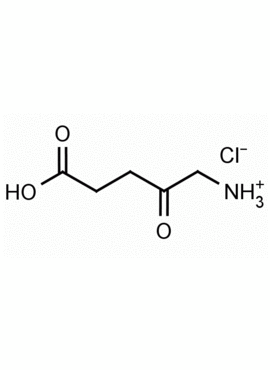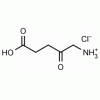delta-Aminolevulinic acid hydrochloride 5-Amino-4-oxopentanoic acid hydrochloride ( ALA) CAS: 5451-09-2 MDL: MFCD00012869
Field of Interest: Natural Products Synthesis, Porphyrias, Heme precursor
Molecular weight: 167.59 g/mol
Molecular Formula: C5H9NO3·HCl
CAS Number: 5451-09-2
Storage: Store at 0 – 4 °C
Synonyms: 5 Aminolaevulinate, 5 Aminolevulinate, 5-Aminolaevulinate, 5-Aminolevulinate, Acid Hydrochloride, Aminolevulinic, Acid, Aminolevulinic Acid, Delta-Aminolevulinic, Aminolevulinic Acid, Aminolevulinic Acid Hydrochloride, Delta Aminolevulinic Acid, Delta-Aminolevulinic Acid Hydrochloride, Aminolevulinic Acid, Levulan, 5-ALA
Background: delta-Aminolevulinic acid is an endogenous compound in the porphyrin synthesis pathways of heme and chlorophyll, and in photodynamic therapy, where 5ALA is being studied in different types of cancer 1-3 It also is a main indicator of altered metabolism and indicator of porphyria disease and dioxin exposure, and found in the urine of experimental animals exposed to 2,3,7,8-tetrachlorodibenzo-p-dioxin (I) [1746-01-6], and in the urine of construction workers exposed to lead. 4-6
References:
1.) Ryter, S. W., Tyrrell, R. M., The heme synthesis and degradation pathways: role in oxidant sensitivity. Heme oxygenase has both pro- and antioxidant properties, Free Radical Biology & Medicine (2000), 28(2), 289-309.
2.) Meskauskiene, Rasa, Nater, Mena, Goslings, David, Kessler, Felix, op den Camp, Roel, Apel, Klaus, FLU: a negative regulator of chlorophyll biosynthesis in Arabidopsis thaliana, Proceedings of the National Academy of Sciences of the United States of America (2001), 98(22), 12826-12831.
3.) Kadish, Karl M., Smith, Kevin M., Guilard, Roger, Porphyrins as photosensitizers in photodynamic therapy, Porphyrin Handbook (2000), 6, 157-230.
4.) Mauzerall, D., Granick, S., The occurrence and determination of δ-aminolevulinic acid and porphobilinogen in urine, Journal of Biological Chemistry (1956), 219, 435-46.
5.) Kociba, R. J., Keyes, D. G., Beyer, J. E., Carreon, R. M., Wade, C. E., Dittenber, D. A., Kalnins, R. P., Frauson, L E., Park, C. N., et al., Results of a two-year chronic toxicity and oncogenicity study of 2,3,7,8-tetrachlorodibenzo-p-dioxin in rats, Toxicology and Applied Pharmacology (1978), 46(2), 279-303.
6) Patil, Neelam J., Bhatt, Pooja V., Patharkar, Sachin A., Nerurkar, Alka V., Surve, Pradeep N., Bhatia, Kapil, Determination of delta aminolevulinic acid levels in urine, a sensitive indicator of lead exposure in construction workers, Al Ameen Journal of Medical Sciences (2020), 13(3), 172-177.

